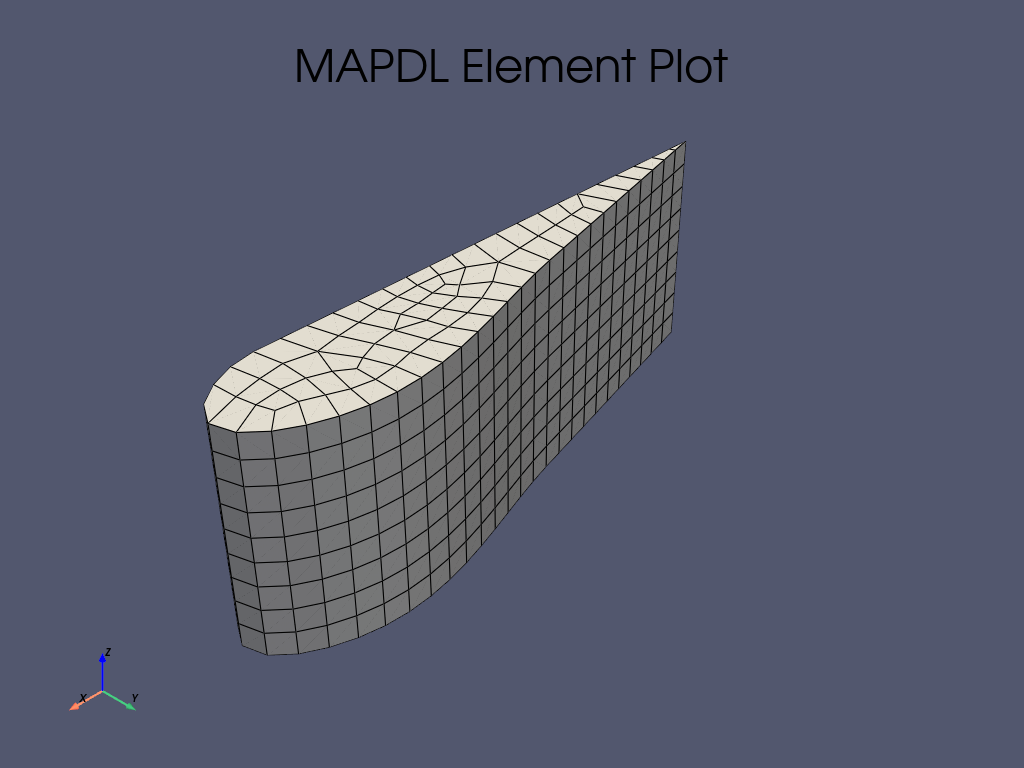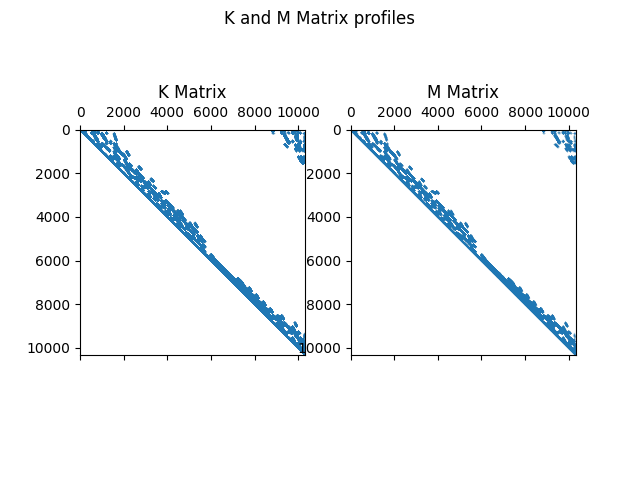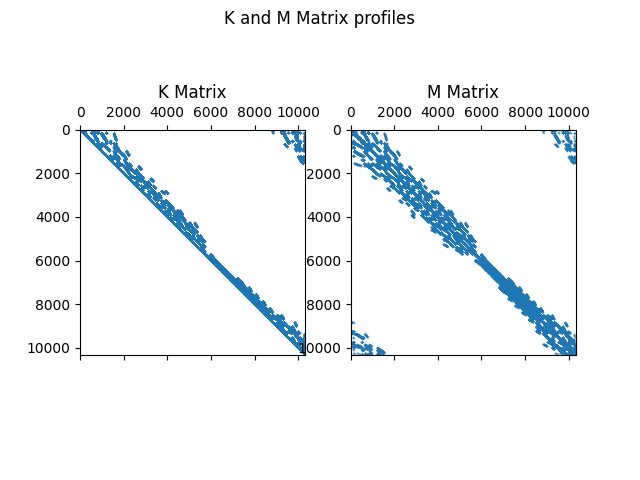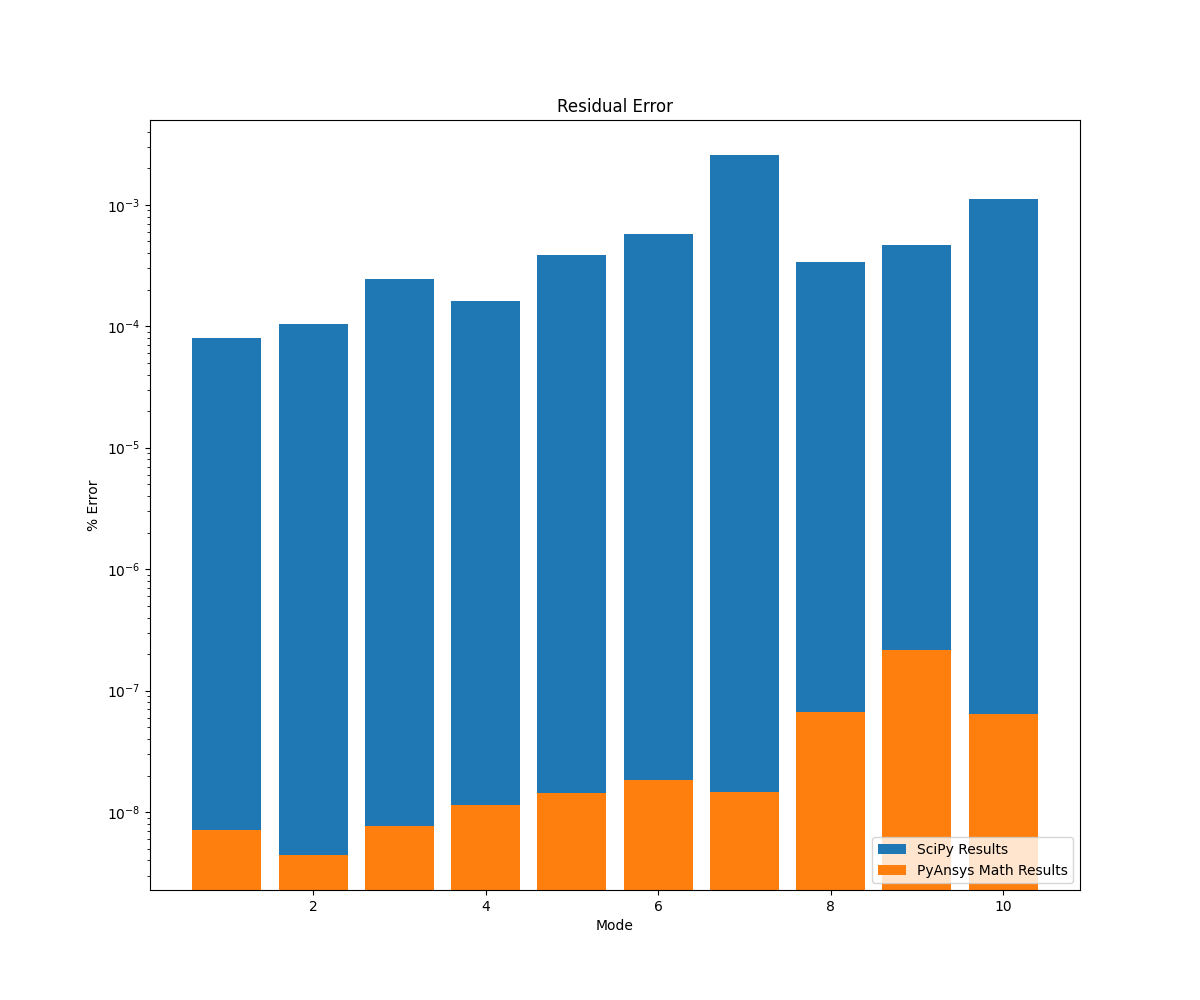Note
Go to the end to download the full example code.
Compute Eigenvalues using PyAnsys Math and SciPy#
This example shows how to perform these tasks:
Extract the stiffness and mass matrices from an MAPDL model.
Use PyAnsys Math to compute the first eigenvalues.
Get these matrices using SciPy to obtain the same solutions using Python resources.
See if PyAnsys Math is more accurate and faster than SciPy.
Perform required imports and start PyAnsys Math#
Perform required imports.
import math
import time
from ansys.mapdl.core.examples import examples
import matplotlib.pylab as plt
import numpy as np
import scipy
from scipy.sparse.linalg import eigsh
import ansys.math.core.math as pymath
# Start PyAnsys Math as a service.
mm = pymath.AnsMath()
Load the input file#
Load the input file using MAPDL.
print(mm._mapdl.input(examples.wing_model))
/INPUT FILE= LINE= 0
*** WARNING *** CP = 0.000 TIME= 00:00:00
The /BATCH command must be the first line of input. The /BATCH command
is ignored.
*****MAPDL VERIFICATION RUN ONLY*****
DO NOT USE RESULTS FOR PRODUCTION
***** MAPDL ANALYSIS DEFINITION (PREP7) *****
*** WARNING *** CP = 0.000 TIME= 00:00:00
Deactivation of element shape checking is not recommended.
*** WARNING *** CP = 0.000 TIME= 00:00:00
The mesh of area 1 contains PLANE42 triangles, which are much too stiff
in bending. Use quadratic (6- or 8-node) elements if possible.
*** WARNING *** CP = 0.000 TIME= 00:00:00
CLEAR, SELECT, and MESH boundary condition commands are not possible
after MODMSH.
***** ROUTINE COMPLETED ***** CP = 0.000
Plot and mesh#
Plot and mesh using the eplot method.
mm._mapdl.eplot()

[82, 87, 110]
Set up modal analysis#
Set up a modal analysis and form the \(K\) and \(M\) matrices.
MAPDL stores these matrices in a .FULL file.
print(mm._mapdl.slashsolu())
print(mm._mapdl.antype(antype="MODAL"))
print(mm._mapdl.modopt(method="LANB", nmode="10", freqb="1."))
print(mm._mapdl.wrfull(ldstep="1"))
# store the output of the solve command
output = mm._mapdl.solve()
***** MAPDL SOLUTION ROUTINE *****
PERFORM A MODAL ANALYSIS
THIS WILL BE A NEW ANALYSIS
USE SYM. BLOCK LANCZOS MODE EXTRACTION METHOD
EXTRACT 10 MODES
SHIFT POINT FOR EIGENVALUE CALCULATION= 1.0000
NORMALIZE THE MODE SHAPES TO THE MASS MATRIX
STOP SOLUTION AFTER FULL FILE HAS BEEN WRITTEN
LOADSTEP = 1 SUBSTEP = 1 EQ. ITER = 1
Read sparse matrices#
Read the sparse matrices using PyAnsys Math.
mm._mapdl.finish()
mm.free()
k = mm.stiff(fname="file.full")
M = mm.mass(fname="file.full")
Solve eigenproblem#
Solve the eigenproblme using PyAnsys Math.
Elapsed time to solve this problem : 0.4201931953430176
Print eigenfrequencies and accuracy#
Print the eigenfrequencies and the accuracy.
Accuracy : \(\frac{||(K-\lambda.M).\phi||_2}{||K.\phi||_2}\)
pymath_acc = np.empty(nev)
for i in range(nev):
f = ev[i] # Eigenfrequency (Hz)
omega = 2 * np.pi * f # omega = 2.pi.Frequency
lam = omega**2 # lambda = omega^2
phi = A[i] # i-th eigenshape
kphi = k.dot(phi) # K.Phi
mphi = M.dot(phi) # M.Phi
kphi_nrm = kphi.norm() # Normalization scalar value
mphi *= lam # (K-\lambda.M).Phi
kphi -= mphi
pymath_acc[i] = kphi.norm() / kphi_nrm # compute the residual
print(f"[{i}] : Freq = {f:8.2f} Hz\t Residual = {pymath_acc[i]:.5}")
[0] : Freq = 352.39 Hz Residual = 7.1398e-09
[1] : Freq = 385.20 Hz Residual = 4.4352e-09
[2] : Freq = 656.78 Hz Residual = 7.6434e-09
[3] : Freq = 764.73 Hz Residual = 1.1473e-08
[4] : Freq = 825.49 Hz Residual = 1.4281e-08
[5] : Freq = 1039.25 Hz Residual = 1.8512e-08
[6] : Freq = 1143.60 Hz Residual = 1.4537e-08
[7] : Freq = 1258.00 Hz Residual = 6.6247e-08
[8] : Freq = 1334.23 Hz Residual = 2.154e-07
[9] : Freq = 1352.10 Hz Residual = 6.4539e-08
Use SciPy to solve the same eigenproblem#
Get the MAPDL sparse matrices into Python memory as SciPy matrices.

Make the sparse matrices for SciPy unsymmetric because symmetric matrices in SciPy are memory inefficient.
\(K = K + K^T - diag(K)\)
pkd = scipy.sparse.diags(pk.diagonal())
pK = pk + pk.transpose() - pkd
pmd = scipy.sparse.diags(pm.diagonal())
pm = pm + pm.transpose() - pmd
Plot the matrices.

Solve the eigenproblem.
Elapsed time to solve this problem : 2.223806858062744
Convert lambda values to frequency values: \(freq = \frac{\sqrt(\lambda)}{2.\pi}\)
Compute the residual error for SciPy.
\(Err=\frac{||(K-\lambda.M).\phi||_2}{||K.\phi||_2}\)
scipy_acc = np.zeros(nev)
for i in range(nev):
lam = vals[i] # i-th eigenvalue
phi = vecs.T[i] # i-th eigenshape
kphi = pk * phi.T # K.Phi
mphi = pm * phi.T # M.Phi
kphi_nrm = np.linalg.norm(kphi, 2) # Normalization scalar value
mphi *= lam # (K-\lambda.M).Phi
kphi -= mphi
scipy_acc[i] = 1 - np.linalg.norm(kphi, 2) / kphi_nrm # compute the residual
print(f"[{i}] : Freq = {freqs[i]:8.2f} Hz\t Residual = {scipy_acc[i]:.5}")
[0] : Freq = 352.39 Hz Residual = 8.0111e-05
[1] : Freq = 385.20 Hz Residual = 0.00010356
[2] : Freq = 656.78 Hz Residual = 0.00024284
[3] : Freq = 764.73 Hz Residual = 0.00016261
[4] : Freq = 825.49 Hz Residual = 0.00038862
[5] : Freq = 1039.25 Hz Residual = 0.00057672
[6] : Freq = 1143.60 Hz Residual = 0.0025674
[7] : Freq = 1258.00 Hz Residual = 0.00033886
[8] : Freq = 1334.23 Hz Residual = 0.00046688
[9] : Freq = 1352.10 Hz Residual = 0.0011237
See if PyAnsys Math is more accurate than SciPy#
Plot residual error to see if PyAnsys Math is more accurate than SciPy.
fig = plt.figure(figsize=(12, 10))
ax = plt.axes()
x = np.linspace(1, 10, 10)
plt.title("Residual Error")
plt.yscale("log")
plt.xlabel("Mode")
plt.ylabel("% Error")
ax.bar(x, scipy_acc, label="SciPy Results")
ax.bar(x, pymath_acc, label="PyAnsys Math Results")
plt.legend(loc="lower right")
plt.show()

See if PyAnsys Math is faster than SciPy#
Plot elapsed time to see if PyAnsys Math is more accurate than SciPy.
ratio = scipy_elapsed_time / pymath_elapsed_time
print(f"PyAnsys Math is {ratio:.3} times faster.")
PyAnsys Math is 5.29 times faster.
Stop PyAnsys Math#
Stop PyAnsys Math.
mm._mapdl.exit()
Total running time of the script: (0 minutes 9.571 seconds)

